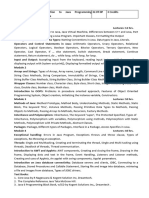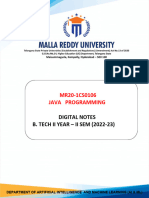0 ratings0% found this document useful (0 votes)
4 viewsJava Programming Exam Notes
The document provides exam notes on Java programming, covering key concepts such as Java features, basic program structure, data types, string management, inheritance, methods, control structures, and GUI development using AWT. It explains the differences between compiling and running a program, as well as between primitive and reference types. Additionally, it discusses client-server concepts and the HTTP protocol for web data transfer.
Uploaded by
Aditya KumarCopyright
© © All Rights Reserved
We take content rights seriously. If you suspect this is your content, claim it here.
Available Formats
Download as PDF, TXT or read online on Scribd
0 ratings0% found this document useful (0 votes)
4 viewsJava Programming Exam Notes
The document provides exam notes on Java programming, covering key concepts such as Java features, basic program structure, data types, string management, inheritance, methods, control structures, and GUI development using AWT. It explains the differences between compiling and running a program, as well as between primitive and reference types. Additionally, it discusses client-server concepts and the HTTP protocol for web data transfer.
Uploaded by
Aditya KumarCopyright
© © All Rights Reserved
We take content rights seriously. If you suspect this is your content, claim it here.
Available Formats
Download as PDF, TXT or read online on Scribd
You are on page 1/ 3
Java Programming - Exam Notes
UNIT-I: Introduction to Java Programming
1. What is Java? Explain its features.
Java is a high-level, object-oriented programming language. Features: Platform-independent, Secure, Robust,
Multi-threaded, Portable.
2. How do you write a basic Java program?
class HelloWorld {
public static void main(String[] args) {
System.out.println("Hello, World!");
3. Difference between compiling and running a Java program:
- Compiling: Converts source code to bytecode using javac.
- Running: Uses java to run bytecode on the JVM.
UNIT-II: Data Types and Strings
1. Java primitive types: byte, short, int, long, float, double, char, boolean.
2. Difference between primitive and reference types:
- Primitive stores values.
- Reference stores addresses of objects.
Java Programming - Exam Notes
3. String vs new String():
- "Java" uses string pool.
- new String("Java") creates a new object.
4. String memory management:
Java uses a String Pool in heap memory for unique literals.
UNIT-III: Classes, Methods, and Control Structures
1. What is Inheritance?
Inheritance allows a class to inherit properties and methods from another class.
2. Declaring and invoking methods:
public int add(int a, int b) { return a + b; }
int result = add(10, 20);
3. Loop types:
- For loop: for(int i=0; i<5; i++)
- While loop: while(i < 5)
- Do-while: do { } while(i < 5);
4. Control statements:
- if, if-else, switch, break, continue, return
UNIT-IV: GUI and Client/Server Concepts
Java Programming - Exam Notes
1. What is AWT?
Java's API for GUI development.
2. GUI with AWT example:
Frame, Button, setBounds, setSize, setLayout, setVisible.
3. Client-side vs Server-side scripting:
- Client: JavaScript
- Server: Servlets, ASP
4. What is HTTP?
HTTP is a protocol for data transfer on the web using request-response.
You might also like
- Java Multithreading Interview Questions And AnswersFrom EverandJava Multithreading Interview Questions And AnswersNo ratings yet
- (502) Java Programming and Dynamic Web page Design NotesNo ratings yet(502) Java Programming and Dynamic Web page Design Notes46 pages
- BS-210 Core Java Programming Lab Manual: C T Group of Institutions JalandharNo ratings yetBS-210 Core Java Programming Lab Manual: C T Group of Institutions Jalandhar48 pages
- Engineering College, Ajmer: Department of Computer ScienceNo ratings yetEngineering College, Ajmer: Department of Computer Science19 pages
- Introduction To Java Programming LanguageNo ratings yetIntroduction To Java Programming Language2 pages
- Object Oriented Programming Through JavaNo ratings yetObject Oriented Programming Through Java16 pages
- Umesh Patidar PPT On Java Final PPT 011No ratings yetUmesh Patidar PPT On Java Final PPT 01123 pages
- NOTES_Module-1-PROGRAMMING IN JAVA_CSE2006No ratings yetNOTES_Module-1-PROGRAMMING IN JAVA_CSE200617 pages
- The Java Workshop: Learn object-oriented programming and kickstart your career in software developmentFrom EverandThe Java Workshop: Learn object-oriented programming and kickstart your career in software developmentNo ratings yet



























































